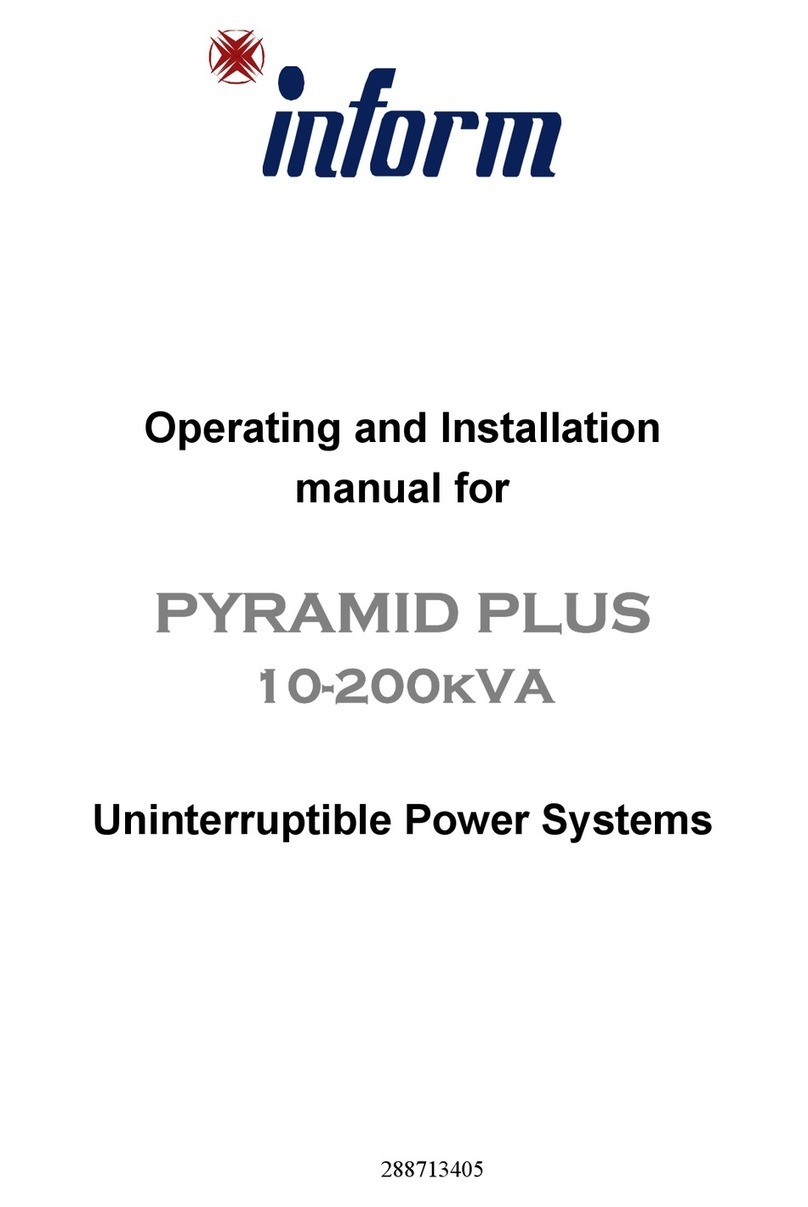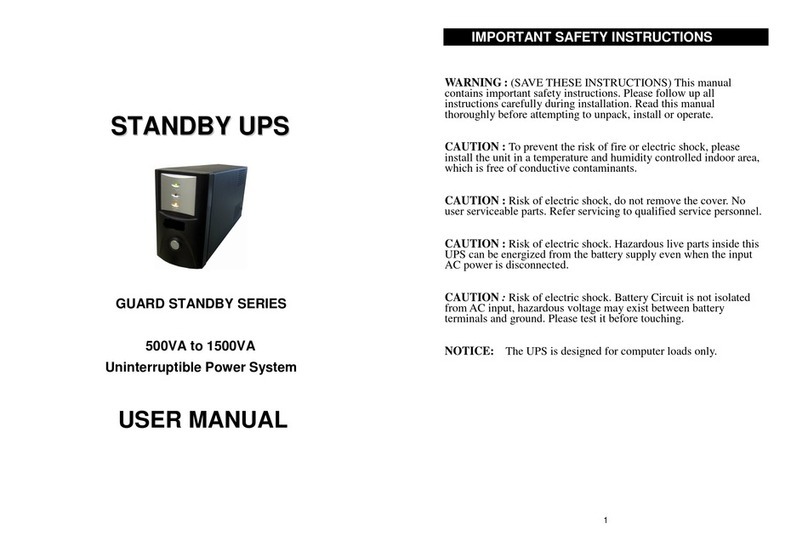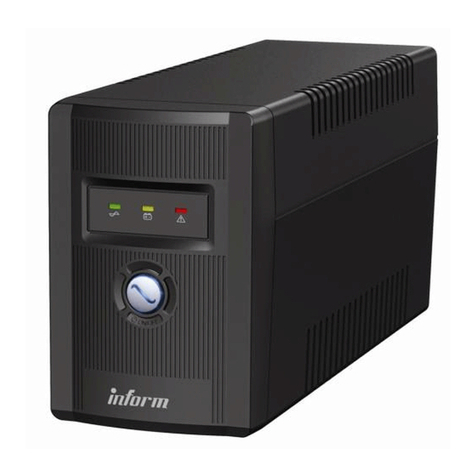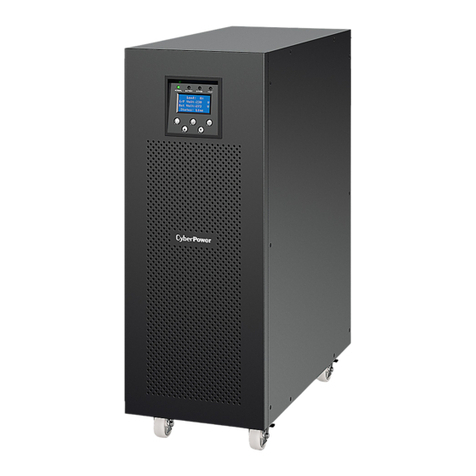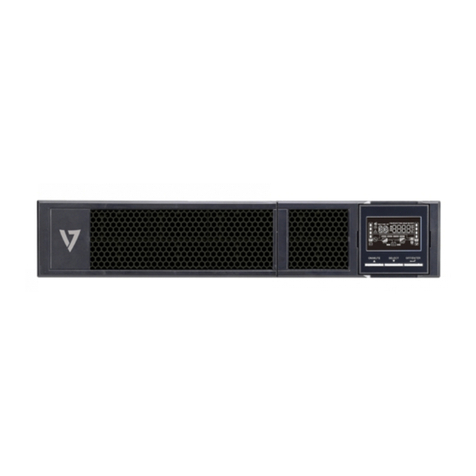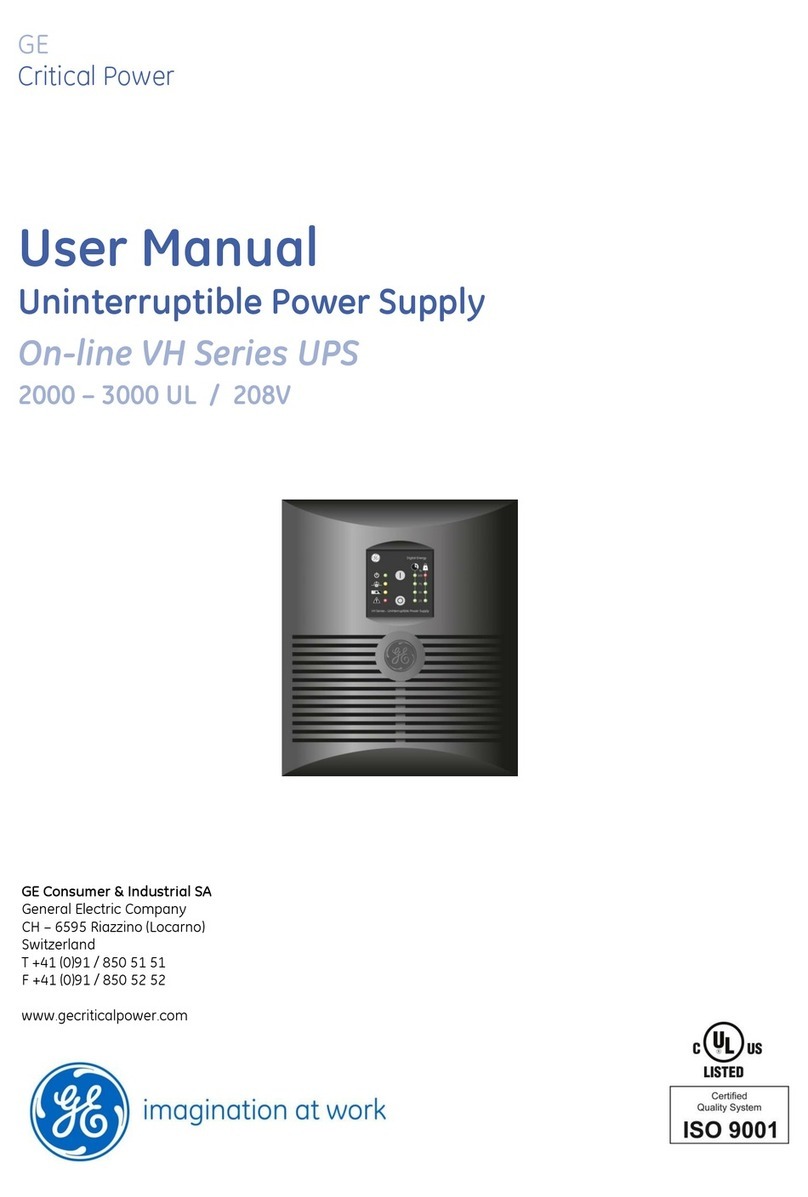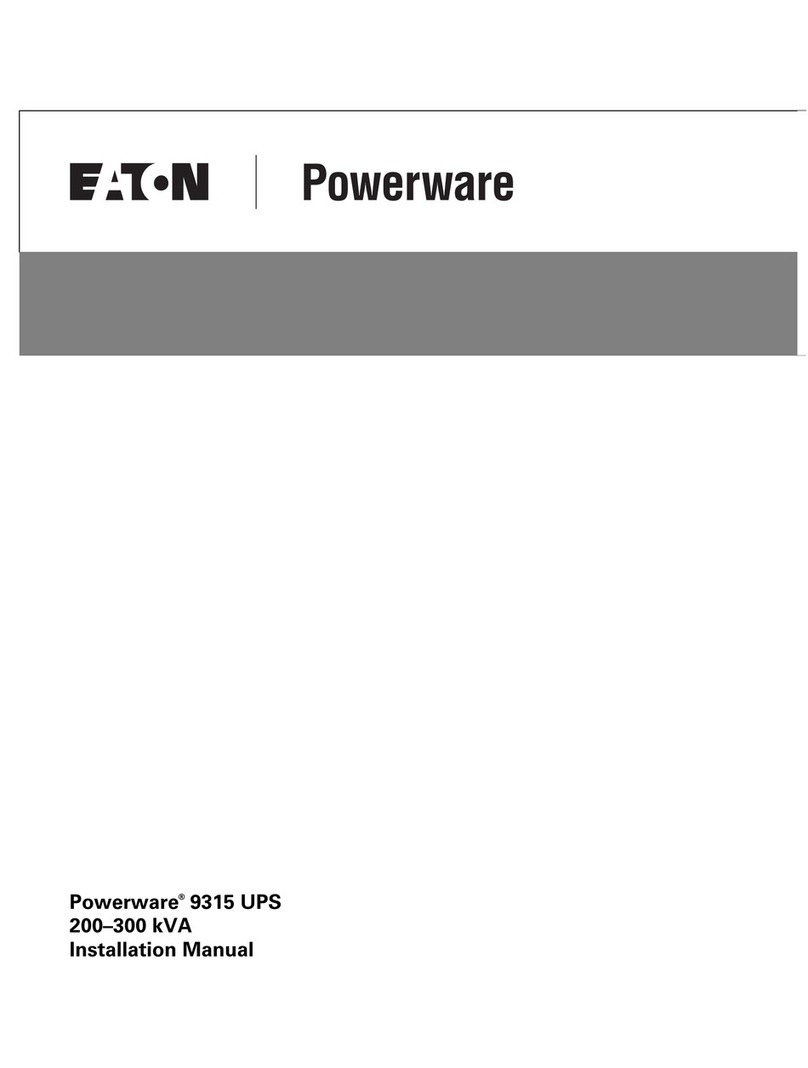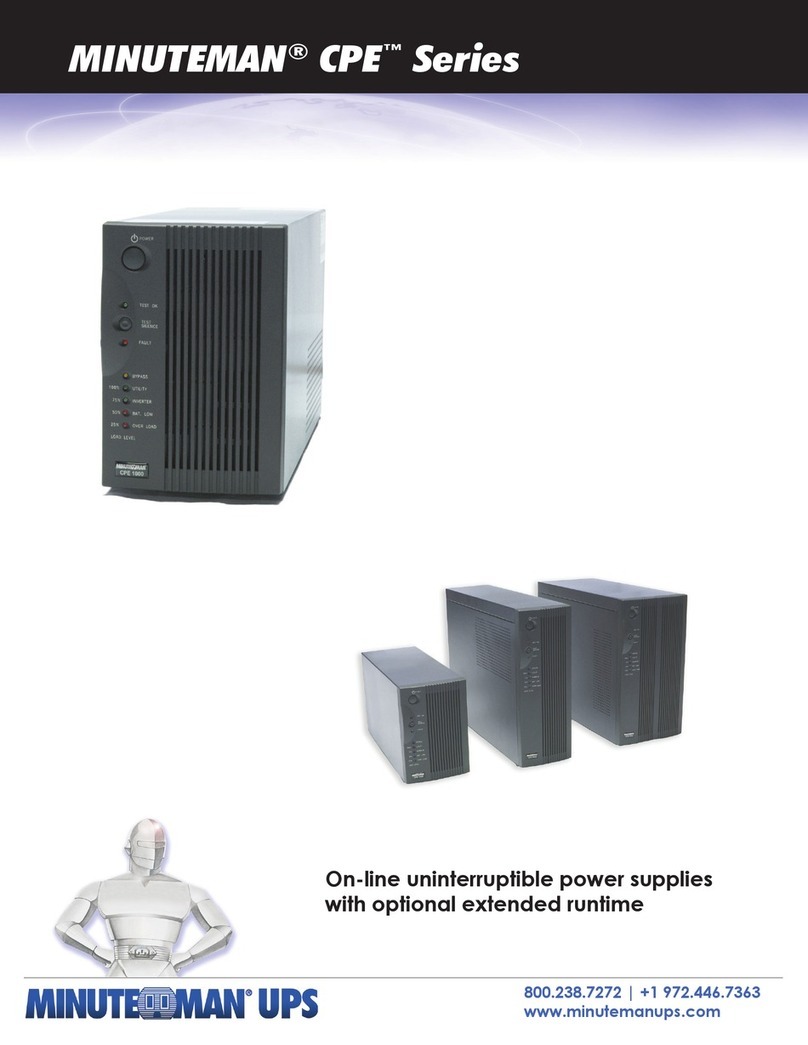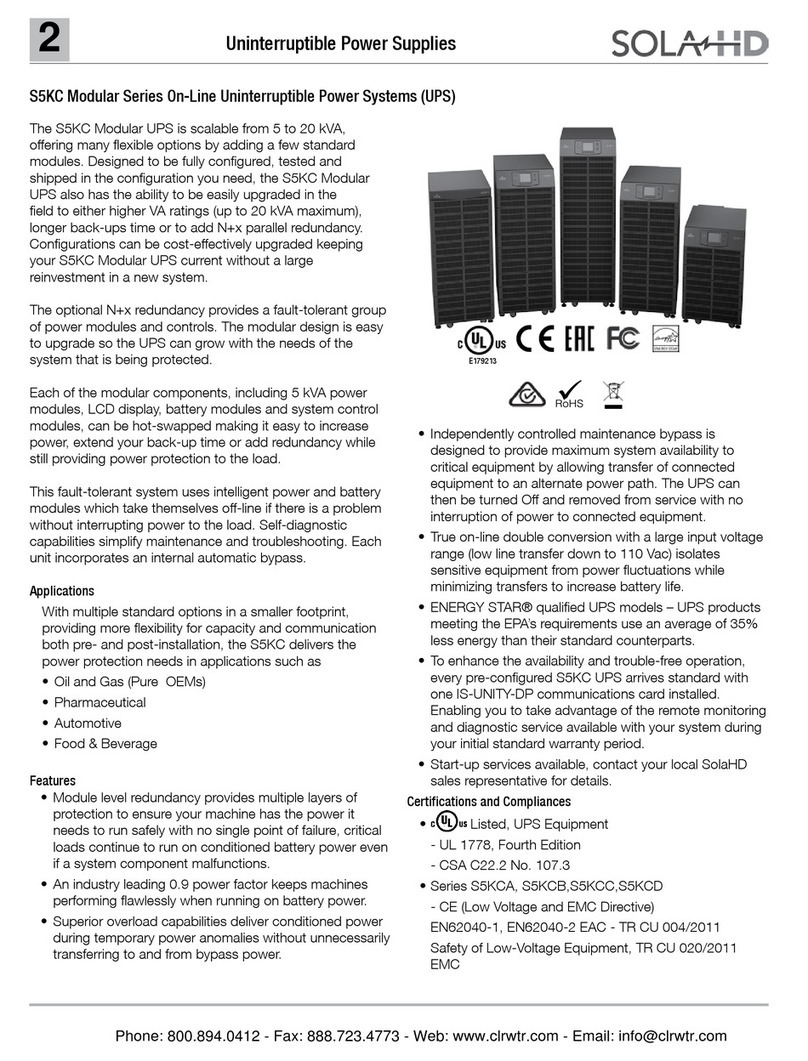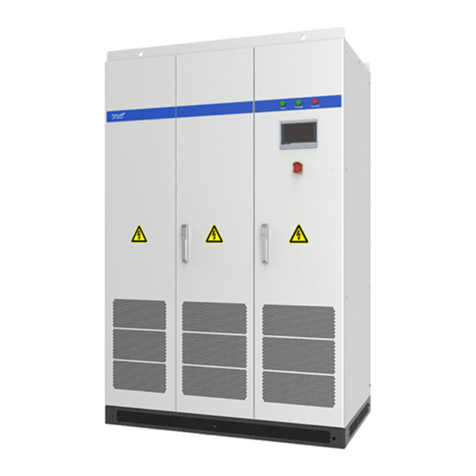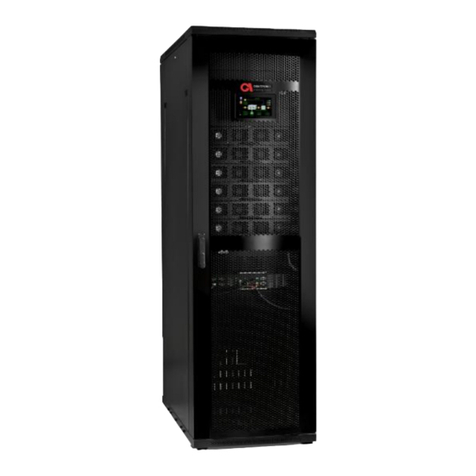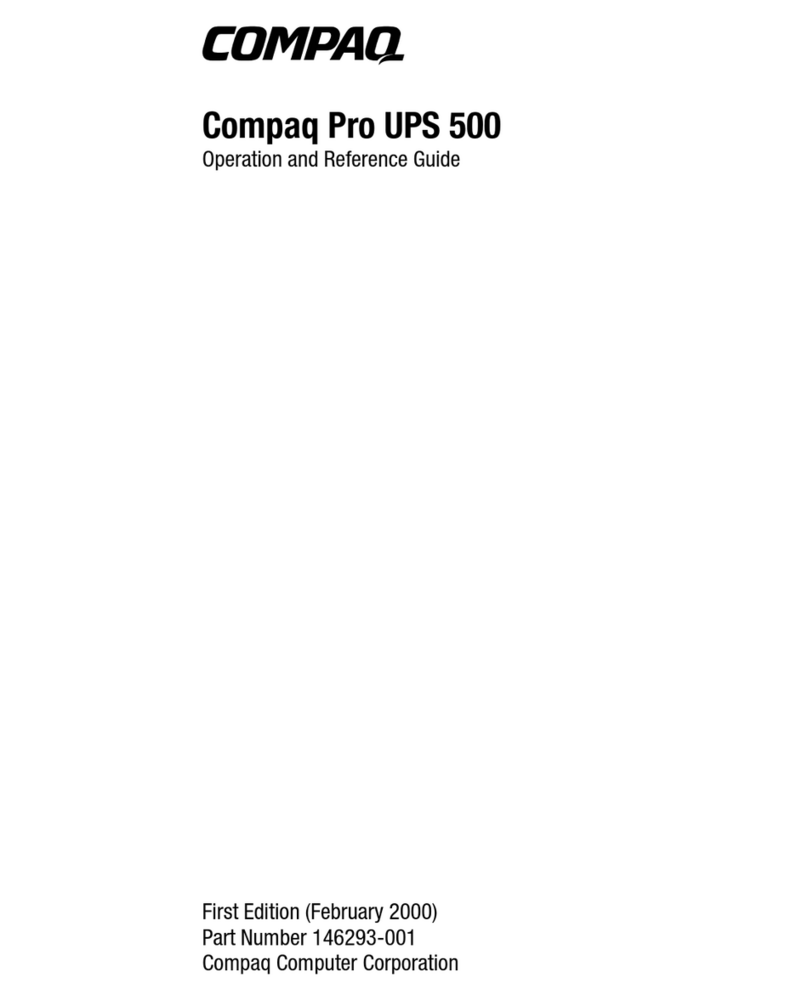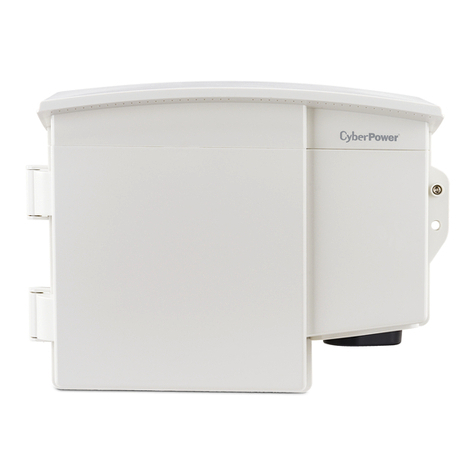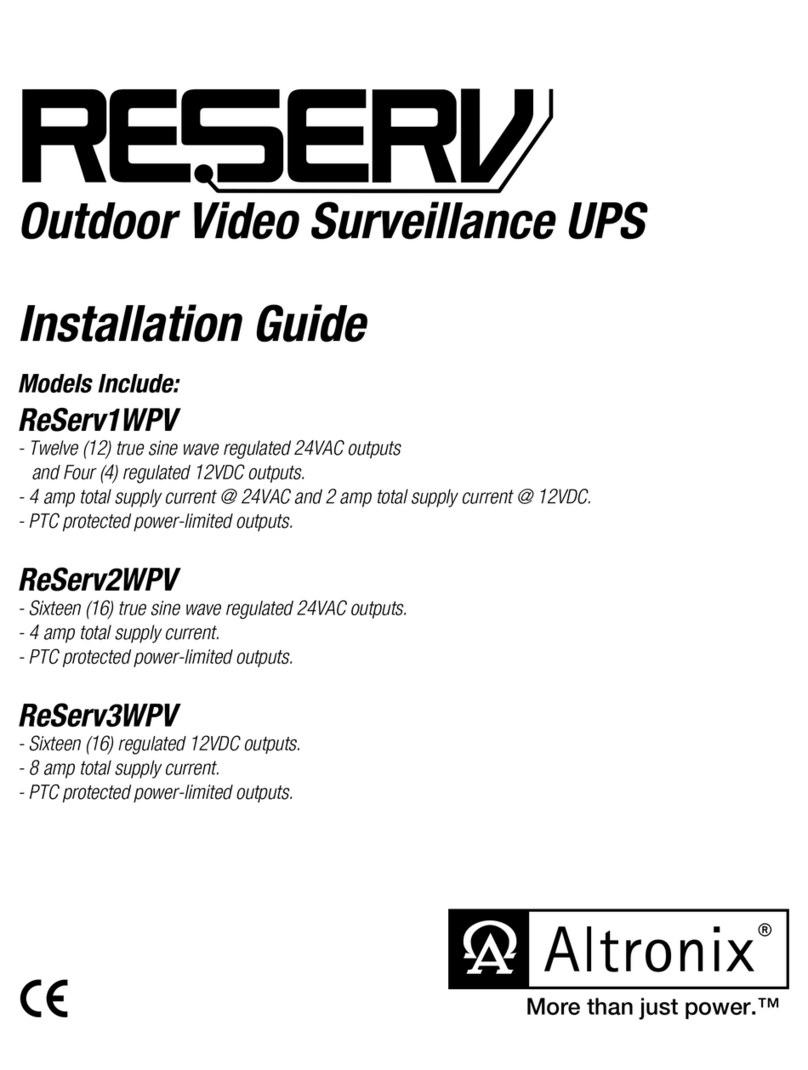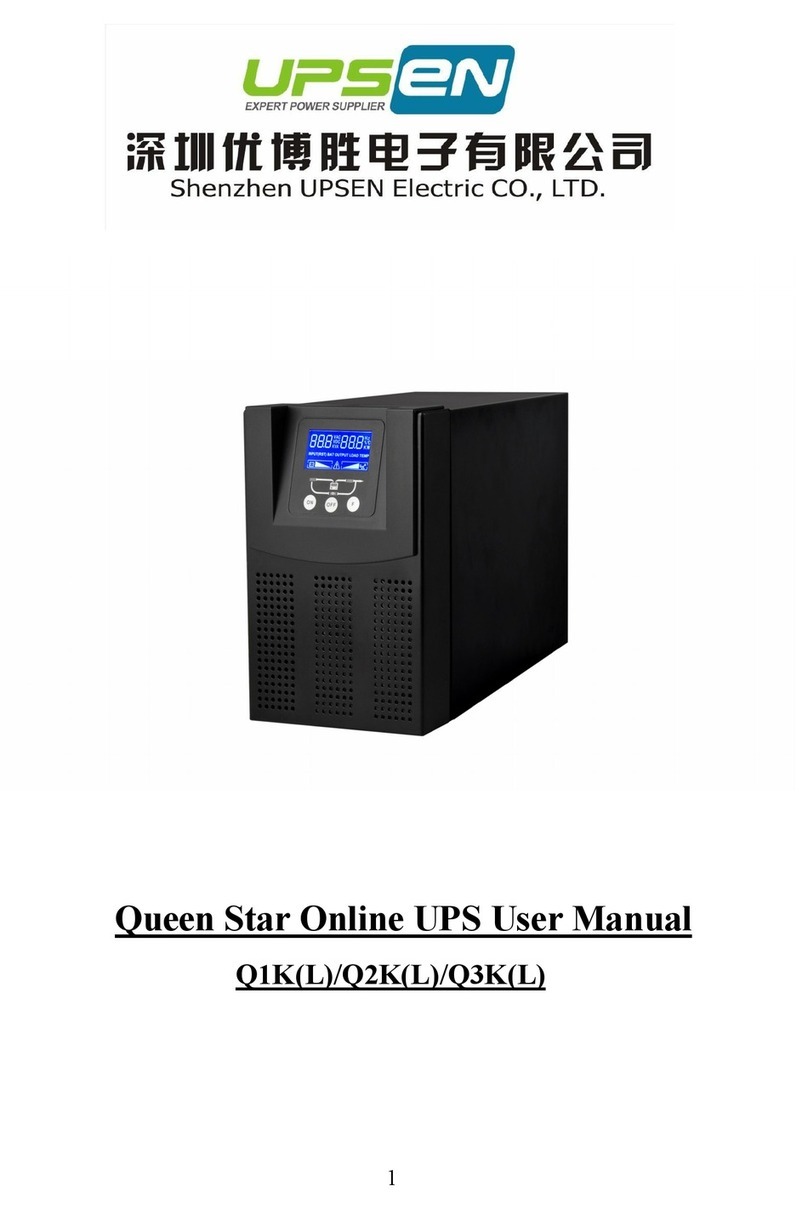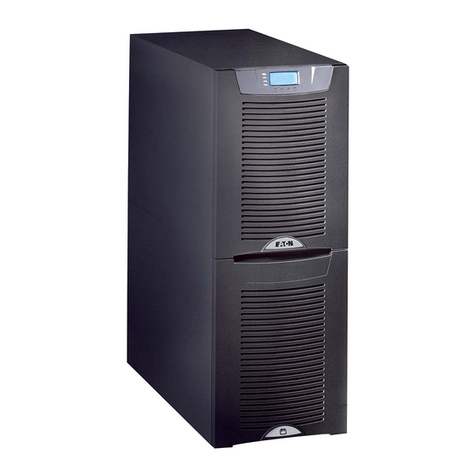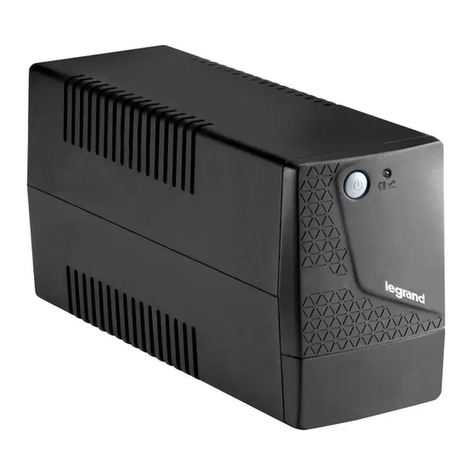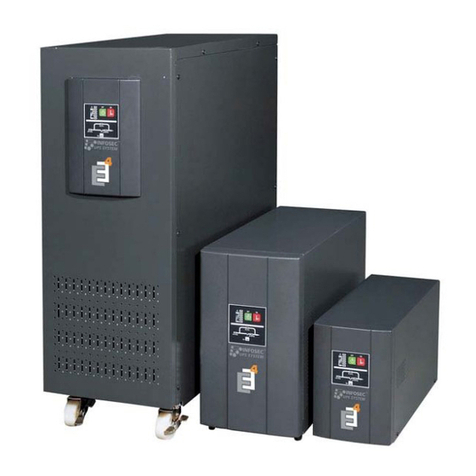inform Pyramid DSP T Specification sheet

1
Operating and Installation
manual for
PYRAM
PYRAMPYRAM
PYRAMID DSP T
D DSP TD DSP T
D DSP T
1
11
10
00
0
-
--
-
12
1212
120kVA
0kVA0kVA
0kVA
Uninterruptible Power Systems

2
Important Notice
Thank you for purchasing Inform UPS.
This document provides instructions about safety, installation and handling of the UPS. It is necessary to
read the manual completely before orking on this equipment.
Read the manual completely before orking on this equipment!
Keep this manual near UPS for easy consultation!
Symbols
This symbol points out the instructions hich are especially important.
This symbol points out the risk of electric shock if the follo ing instruction is not obeyed.
This symbol points out the instructions, hich may be resulted ith the injury of the operator or
damage of the equipment if not obeyed.

3
Index
1
Safety ...................................................................................................................................................... 5
2
Installation ............................................................................................................................................. 6
2nd1
Transportation ................................................................................................................................................................... 6
2nd2
Unpacking........................................................................................................................................................................... 6
2nd3
Storage ................................................................................................................................................................................. 6
2nd4
Placement ........................................................................................................................................................................... 6
2nd4.1
Environmental Requisites ....................................................................................................................................... 6
2nd4.2
Electrical Requisites .................................................................................................................................................. 7
2nd5
Connections ....................................................................................................................................................................... 8
2nd5.1
Po er Connections .................................................................................................................................................. 8
2nd5.1.1
Protective Earth (Ground) Connections ............................................................................................................... 11
2nd5.1.2
Input Connection ....................................................................................................................................................... 11
2nd5.1.3
Separated by-pass mains input connection (optional) ........................................................................................ 11
2nd5.1.4
External Battery Connection .................................................................................................................................... 11
2nd5.1.5
Output Connection .................................................................................................................................................... 12
2nd5.2
Communication Interface Connections.............................................................................................................. 12
3
Modes of Operation .............................................................................................................................. 13
3rd1
Bypass Mode .................................................................................................................................................................... 14
3rd2
Normal Mode .................................................................................................................................................................. 15
3rd3
Battery Mode .................................................................................................................................................................... 15
4
Control and Monitorin ........................................................................................................................ 16
4th1
Front Panel ....................................................................................................................................................................... 16
4th1.1
Keypad ...................................................................................................................................................................... 16
4th1.2
Mimic Panel ............................................................................................................................................................. 17
4th1.3
Liquid Crystal Display (LCD) and User Menu .................................................................................................. 18
4th1.4
Buzzer ....................................................................................................................................................................... 21
5
Operatin Procedures .......................................................................................................................... 22
5th1
Commissioning ................................................................................................................................................................ 22
5th2
Decommissioning ........................................................................................................................................................... 22
5th3
S itching into manual by-pass during operation ...................................................................................................... 23
5th4
Returning from manual bypass to UPS ....................................................................................................................... 23
5th5
Connection to a generator ............................................................................................................................................. 23
6
Operatin Procedures for Parallel Systems .......................................................................................... 24
6th1
Introduction ..................................................................................................................................................................... 24
6th2
Procedure for Commissioning and Start Up ( First Installation ) .......................................................................... 24
6th3
Procedure for Transferring to Static Bypass .............................................................................................................. 27
6th4
Procedure for Transferring to ( Maintenance ) Manual Bypass .............................................................................. 27
6th5
Procedure for S itching OFF ...................................................................................................................................... 27
7
Features and operatin limits .............................................................................................................. 28
7th1
Mains limits for normal operation ............................................................................................................................... 28
7th2
By-pass mains limits for bypass operation.................................................................................................................. 28
7th3
Battery test ........................................................................................................................................................................ 28
7th4
Overload behavior .......................................................................................................................................................... 29
7th5
Electronic short circuit protection ............................................................................................................................... 29

4
8
Communication ................................................................................................................................... 30
8th1
RS232 Communication .................................................................................................................................................. 30
8th2
RS422 Communication .................................................................................................................................................. 30
8th3
Digital Inputs (UPS OFF and GEN ON) .................................................................................................................. 31
8th4
Free Contact Communication ...................................................................................................................................... 31
9
Maintenance ......................................................................................................................................... 32
9th1
Battery fuses ..................................................................................................................................................................... 32
9th2
Batteries ............................................................................................................................................................................ 32
9th3
Fans ................................................................................................................................................................................... 32
9th4
Capacitors ......................................................................................................................................................................... 32
10
Troubleshootin ................................................................................................................................... 33
11
Technical Specifications ...................................................................................................................... 36

5
1Safety
Information related to the safety of the UPS, loads and the user is summarized belo .
But the equipment should not be installed before reading the manual completely.
The equipment may only be installed and commissioned by authorized technical persons.
When the UPS is brought from a cold place to a armer place, humidity of the air may
condensate in it. In this case, ait for t o hours before beginning ith the installation.
Even ith no connections have been done, hazardous voltages may exist on connection terminals
and inside the UPS. Do not touch these parts.
Connect the PE ground connector before connecting any other cable.
Do not put the battery fuses into the fuse holder before operating the equipment and seeing the
“NORMAL” message on the LCD.
The connections shall be made ith cables of appropriate cross-section in order to prevent the
risk of fire. All cables shall be of insulated type and shall not be laid out on the alking path of
the persons.
Do not expose UPS to rain or liquids in general. Do not introduce any solid objects.
The equipment shall be operated in an environment, hich is specified in “placement” section of
this manual.
Affix a label bearing the follo ing expression, on the distribution panels feeding the UPS :
“Isolate the Uninterruptible Po er Supply before orking on this circuit”
Do not plug the communication cables in or out during stormy eather.
The equipment shall only be maintained and fixed by authorized technical persons.
In case of an extraordinary situation (damaged cabin or connections, penetration of foreign
materials into the cabin etc.) deenergize the UPS immediately and consult to the technical service.
Replaced batteries must be disposed of at authorized aste disposal centers.
Keep this manual near for easy consultation.
The equipment shall be packed properly during transportation.
The equipment is compliant ith the European Community directives. Hence it is marked:

6
2Installation
2nd1 Transportation
The UPS must remain in a vertical position throughout the transportation.
Make sure that the floor can support the eight of the system.
2nd2 Unpackin
Equipment and batteries hose packages are damaged during transportation shall be inspected by
a qualified technical person before starting ith the installation.
The procedure is as follo ing:
Remove the bands and the protective packaging from the UPS.
Use suitable equipment to remove the UPS from the pallet.
Mount the cabinet parts supplied ith the UPS after positioning and connecting the UPS.
The equipment shall be packed properly during transportation. Therefore it is recommended to
keep the original package for feature need.
Check if the follo ing are provided ith the equipment
Key of the cabin door
Battery fuses (three pieces)
Test report
2nd3 Stora e
Recommended storage temperature, humidity and altitude values are listed on the “Technical
specifications” section.
If the batteries ill be stored for longer than 2 months, they shall be charged periodically. Charge period
depends on the storage temperature. The relationship is as sho n belo :
Every 9 months if the temperature is belo 20 °C,
Every 6 months if the temperature is bet een 20 °C and 30 °C,
Every 3 months if the temperature is bet een 30 °C and 40 °C,
Every 2 months if the temperature is over 40 °C
2nd4 Placement
2nd4.1 Environmental Requisites
This product meets the safety requirements for devices to be operated in restricted access locations
according to EN 60950-1 safety standard, hich states that the o ner should guarantee the follo ing:
Access to the equipment can only be gained by service persons or by users ho have been
instructed about the reasons for the restrictions applied to the location and about any precautions
that shall be taken and,

7
Access is through the use of a tool or lock and key, or other means of security and is controlled
by the authority responsible for the location.
Recommended operating temperature, humidity and altitude values are listed on the “Technical
specifications” section. Air conditioning may be required to provide these values.
Other requisites are:
The equipment and the batteries shall not be exposed to direct sunlight or placed near to a heat
source.
Do not expose UPS to rain or liquids in general. Do not introduce any solid objects.
Avoid dusty environments or areas here dust of conductive or corrosive materials is present.
Air outlets of the UPS are on sides, front and back except 80kva ups. At 80kva the FANs are on
the tope side of the ups therefore there are no air inlets, outlets at the rear panel at 80kva. Leave
at least 75 cm at the front and both sides and 50 cm at the back for maintenance and ventilation.
At 80kva you do not have to leave any space at the rear part.
2nd4.2 Electrical Requisites
The installation must comply ith national installation regulations.
The electrical distribution panels for the mains and separated by-pass mains inputs must have a protection
and disconnection system. Disconnection devices used in these panels shall disconnect all line conductors
and the neutral conductor simultaneously. The follo ing table sho s the recommended size of the mains
and separate by-pass mains input protection devices (thermal, magnetic and differential) and the cable
cross-sections for the linear loads.
UPS
Input
thermal
protection
Bypass
mains input
thermal
protection
Input cab
le
cross-
section
Bypass
mains input
cable
cross-
section
Battery
cable cross-
section
Neutral
Cable
Cross
section
Leakage
current
protection*
10 kVA (3Ph output)
25 A
25 A
6 mm2
6 mm2
6 mm2
10 mm
2
30 mA
15 kVA (3Ph output)
25 A
25 A
6 mm2
6 mm2
6 mm2
10
mm
2
30 mA
20 kVA (3Ph output)
40 A
40 A
10 mm
2
10 mm
2
10 mm
2
16 mm
2
30 mA
30 kVA (3Ph output)
63 A
63 A
16 mm
2
16 mm
2
16 mm
2
25 mm
2
30 mA
40 kVA (3Ph output)
80 A
80 A
16 mm
2
16 mm
2
16 mm
2
25 mm
2
30 mA
60 kVA (3Ph output)
100 A
100 A
25 mm
2
25 mm
2
25 m
m
2
35 mm
2
30 mA
80 kVA (3Ph output)
125 A
125 A
35 mm
2
35 mm
2
35 mm
2
50 mm
2
30 mA
100 kVA (3Ph output)
160 A
160 A
35 mm
2
35 mm
2
35 mm
2
50 mm
2
30 mA
120 kVA (3Ph output)
200 A
200 A
50 mm
2
50 mm
2
50 mm
2
70 mm
2
30 mA
Input magnetic protection devices shall have D characteristic.
*Load leakage currents are added to those generated by the UPS. If loads ith high leakage currents are
present, adjust this value accordingly. It is recommended to adjust the protective device after measuring
the total leakage current ith the UPS installed and operational ith the intended load.
During transitory phases (po er failure, return and voltage fluctuations) short leakage current peaks may
occur. Make sure that the protection is not activated in such cases.
If the loads have a nonlinear characteristic, the current on the mains input, separate by-pass
mains input and output neutral conductors may have a value that is 1.5-2 times the phase value
during operation. In this case, size the neutral cables and the input/output protection adequately.

8
According to EN 62040-1-2, the user shall place a arning label on the input distribution panel
and the other primary po er isolators, in order to prevent the risk of electric shock caused by a
fault voltage on the UPS. The label shall carry the follo ing ording:
Isolate uninterruptible po er supply before orking on this circuit
2nd5 Connections
Connections shall be done by authorized technical staff only.
When the UPS is brought from a cold place to a armer place, humidity of the air may
condensate in it. In this case, ait for t o hours before beginning ith the installation.
Layout of the connection terminals and boards are sho n belo :
A1: Communication interface board
A2: Parallel connection board (optional)
F1: Input circuit breaker
F2: Output circuit breaker
F3: Manual by-pass circuit breaker
F4: By-pass circuit breaker (optional)
F5: Battery circuit breaker
F6: Inrush fuse
X1: Battery terminals
X2: Input mains terminals
X3: Separate by-pass mains terminals (optional)
X4: Output terminals
2nd5.1 Power Connections
Devices ith internal batteries may have dangerous voltages on the battery terminals
The po er scre terminals are located on the lo er front side of the UPS. Terminal details for ups’s are
sho n separately in the belo figures. Refer to the names of each terminal to identify it during
connection:

9
10-15-20-30kVA (3ph-3ph) UPS Terminal Connections
40- 0kVA UPS Terminal Connections
BATTERY (
-
)
BATTERY
NEUTRAL
BATTERY
(+)
PE
INPUT
L1
INPUT
L2
INPUT
L3
INPUT
NEUTRAL
OUTPUT
L1
OUTPUT
L2
OUTPUT
L3
OUTPUT NEUTRAL
SPLITT
-
BYPASS NEUTRAL
SPLITT BYPA
SS L3
SPLITT BYPASS
L2
SPLITT BYPASS L1
PE
BATTERY (
-
)
BATTERY
NEUTRAL
BATTERY
(+)
IN
PUT
L1
INPUT
L2
INPUT
L3
INPUT NEUTRAL
SPLITT BYPASS NEUTRAL
SPLITT BYPASS L3
SPLITT BYPASS L2
SPLITT BYPASS L1
OUTPUT NEUTRAL
OUTPUT L3
OUTPUT L2
OUTPUT
L1

10
80-100kVA UPS Terminal Connections
120kVA UPS Terminal Connections
PE
BATTERY (
-
)
BATTERY NEUTRAL
BATTERY
(+)
INPUT
L1
INPUT NEUTRAL
INPUT
L2
INPUT
L3
OUTPUT NEUTRAL
OUTPUT L3
SPLITT BYPASS NEUTRAL
SPLITT BYPASS L3
OUTPUT L2
OUTPUT
L1
SPLITT BYPAS
S L2
SPLITT BYPASS L1
OUTPUT NEUTRAL
OUTPUT L3
OUTPUT L2
OUTPUT
L1
SPLITT BYPASS NEUTRAL
SPLITT BYPASS L3
PE
BATTERY (
-
)
BATTERY NEUTRAL
BATTERY
(+)
INPUT
L1
INPUT NEUTRAL
INPUT L2
INPUT L3
SPLITT BYPASS L2
SPLITT BYPASS L1

11
Cables shall be passed through the hole under the connection terminals.
Make sure that all circuit breakers are “OFF”/”0” before starting ith the installation.
Connections shall be done ith the order belo .
2nd5.1.1 Protective Earth (Ground) Connections
The device shall be earthed for a safe and reliable operation.
Connect the PE ground connectors
before connecting any other cable
Input protective earth connection terminal (PE) of the UPS shall be connected to ground ith a lo
impedance connection.
PE terminals of the loads shall be connected to output protective earth terminal of the UPS.
If there is an external battery cabin present, it shall be grounded via battery protective earth terminal of
the UPS.
2nd5.1.2 Input Connection
Bring the circuit breaker on the distribution panel to “OFF” or “0” position before making the
connections
Connect the phases to input (X2) L1, L2 and L3 terminals.
A definite phase sequence is needed for the UPS to operate. If you encounter “IN SEQ FLR” alarm at
start up, decommission the UPS, make the protection devices on the input distribution panels “0”/”OFF”
and interchange any t o phase cable.
Connect neutral to N terminal of X2.
2nd5.1.3 Separated by-pass mains input connection (optional)
Bring the circuit breaker on the distribution panel to “OFF” or “0” position before making the
connections
Connect the phases to bypass (X3) L1, L2 and L3 terminals.
Make sure that the phases have the same sequence ith the input supply.
Connect neutral to N terminal of X3.
2nd5.1.4 External Battery Connection
Do not put the battery fuses into the fuse holder (F5) before operating the equipment and seeing
the “NORMAL” message on the LCD.
Devices ith internal batteries may have dangerous voltages on the battery terminals
To connect external batteries, do the follo ing:

12
S itch the circuit breaker of the external batteries to “OFF” or “0” position.
Connect the (-) pole of the external batteries to the battery (-) terminal,
Connect the (+) pole of the external batteries to the battery (+) terminal,
Connect the midpoint of the external batteries to the battery N terminal.
Danger of explosion and fire if the batteries of the rong type are used.
2nd5.1.5 Output Connection
To enable the short circuit protection feature of the UPS, each load shall be fed over a separate
circuit breaker chosen according to the load current. This may provide quick disconnection of the
short circuited load and operation continuity of the other loads. To obtain maximum protection,
the rating of each individual load circuit breaker shall have the minimum value, hich is enough
to carry the full load current continuously.
Rated apparent and active po er of the loads shall be less than the UPS po er ratings.
Connect the loads to output (X4) Line and N terminals.
2nd5.2 Communication Interface Connections
Related information is given in “communication” section.

13
3Modes of Operation
There are three operation modes, hich differ in the path of the energy flo .
UPS block diagrams and the energy flo path in each operation mode is sho n belo :
When UPS has no separate bypass mains input, bypass line is also fed from the mains input. Thus, if such
a device is in question, mains input shall be comprehended hen the bypass mains input is referred in the
follo ing sections of the manual.
UPS behavior at the start-up is different from the usual operation. The UPS can only operate in bypass
mode during start-up. So, in order for the UPS to start-up, frequency/ aveform/rms value of the bypass
mains voltage shall be in acceptable limits and bypass shall be enabled.

14
After start-up, the follo ing applies:
Operation mode depends on the priority, inverter, rectifier and bypass preferences made by the user and
mains, separate by-pass mains and battery voltages.
Priority and inverter, rectifier and bypass preferences can be set by using the COMMANDS and extra
commands (EXTCMNDS) menus.
If operation in any of these modes is impossible, output voltage ill not be present. In this case, loads ill
not be fed, and “VSECFLR” message is sho n on the LCD instead of operation mode.
3rd1 Bypass Mode
Devices ithout separate bypass mains input, absorb energy from the mains. In devices ith separate
bypass mains input, energy is dra n from the separate bypass mains.
Loads are fed via static bypass line.
Output voltage has the same amplitude, frequency and aveform as the input voltage.
Current dra n by the loads are only limited by the thermal/magnetic s itches over the energy flo path.
Voltage, frequency and aveform of the bypass supply shall be in their tolerance limits, and bypass shall
be enabled for the UPS to operate in this mode.
When the upper provisions are met, the UPS orks in bypass mode in the follo ing conditions:
During the start-up
If the bypass priority is selected
If the inverter is disabled or blocked
In case of a prolonged overload
You can save energy by selecting the bypass priority. Efficiency in bypass mode is higher than the
efficiency in normal mode. If the bypass priority is selected, the UPS ill operate in bypass mode
henever the frequency/ aveform/rms value of bypass mains voltage is in their tolerance limits. If the
bypass voltage goes beyond these limits, the UPS s itches into normal operation.
Bypass mode doesn’t provide perfect stability in frequency/ aveform/rms value of the output
voltage like in normal mode. Thus, the use of this mode should be carefully executed according to
the level of protection required by the application.
Bypass mode doesn’t provide electronic short circuit protection like in normal mode. If a short
circuit or occurs on the output during bypass operation, the thermal/magnetic protection ill act
and all loads ill be deenergized.
Prolonged overloads may cause the thermal/magnetic protection act. In this case, all loads ill be
deenergized.

15
3rd2 Normal Mode
Energy is dra n from the mains input.
Loads are fed via the rectifier and the inverter. The AC voltage at the input is converted to a DC voltage
by the rectifier. The inverter converts this DC voltage to an AC voltage ith a stable sinusoidal aveform,
amplitude and frequency.
Output voltage is sinusoidal and has a regulated amplitude and frequency. It is independent from the input
voltage.
The inverter is synchronized in frequency ith the bypass mains input to enable load transfer to the
bypass supply ithout any interruption, in case of an overload or inverter failure.
Voltage and frequency of the mains input shall be in their tolerance limits, and both the rectifier and the
inverter shall be enabled for the UPS to operate in this mode.
When the upper provisions are met, the UPS orks in normal mode in the follo ing conditions:
If the inverter priority is selected.
If the bypass priority is selected but bypass is disabled or frequency/ aveform/rms value of
bypass mains voltage is not in acceptable limits.
3rd3 Battery Mode
Energy is dra n from the batteries. Loads are fed via the inverter.
Output voltage is sinusoidal and has a regulated amplitude and frequency. It is independent from the
battery voltage.
Battery voltage shall be in acceptable limits and the inverter shall be enabled for the UPS to operate in this
mode.
When the upper provisions are met, the UPS orks in battery mode in the follo ing conditions:
If rectifier is disabled.
If the rectifier is disabled or frequency/ aveform/rms value of mains voltage is not in acceptable
limits.

16
4Control and Monitorin
4th1 Front Panel
The front panel located on the upper part of the UPS informs the user about operating status, alarm
conditions and measurements. It also provides access to controls and configuration parameters.
Front panel sho n belo consists of three parts. As mimic panel provides basic information about the
energy flo path and existing alarms, LCD (liquid crystal display) offers detailed information and provides
access to controls. Keypad enables the user to move in the menu and to make selections.
4th1.1 Keypad
Functions of the buttons are given belo :
BUTTON SYMBOL DEFINITION
ESC
Exit from the current menu
UP
Scrolls the available menus/values up ards. It increases the
value each time it is pushed hen changing a parameter.
DOWN
Scrolls the available menus/values do n ards. It decreases the
value each time it is pushed hen changing a parameter.
ENTER
Enters the menu displayed on the screen. It makes selections or
confirms the choice/changes made.

17
4th1.2 Mimic Panel
Mimic panel is a diagram, hich sho s the path of energy flo in the UPS by means of several LED’s.
Definitions of LED states are sho n belo :
LED's
ID COLOR DEFINITION STATE
Line 1 Green
Input mains voltage is OK and rectifier is active Steady
Input mains voltage is OK and rectifier is inactive
Flashing
Input mains voltage is very close to its upper/lo er limit and rectifier is
active
Input mains voltage is not OK Off
Line 2 Green
Bypass voltage is OK Steady
Bypass voltage is not OK and output voltage is synchronized to the
bypass voltage Flashing
Bypass mains voltage is not OK and output voltage is not synchronized
to the bypass voltage Off
Battery
Red
Battery mode is active and battery voltage is OK Steady
UPS is performing battery test and battery voltage is OK
Battery mode is active and battery voltage is close to its lo er limit
(energy available in the battery is about to be depleted) Flashing
Battery test is active and battery voltage is close to its lo er limit
(energy available in the battery is about to be depleted)
Rectifier is active and able to supply hole po er required by the
inverter Off
Inverter
Green Load is fed via inverter Steady
Inverter is not active Off
Load Green
Load is po ered Steady
Load is po ered but UPS is overloaded Flashing
Output voltage is not OK Off
Bypass Yello Load is fed via static bypass line Steady
Bypass is not active Off
Fault Red
No alarms Off
A minor alarm is present Flashing
A major alarm is present Steady

18
4th1.3 Liquid Crystal Display (LCD) and User Menu
LCD provides detailed information about device status, alarms and measurements. It also enables the
operator to manage the UPS. All information, commands and configuration parameters are given in a
menu, hich has the follo ing structure:
LCD consists of t o lines and has the follo ing structure:
“OPERATING MODE” or “VSECFLR”
“MENU or PARAMETER NAME”
If there is no voltage on the output, VSECFLR message is displayed on the upper line.
Operation mode parameter is one of the notations belo :
OPERATING MODE NOTATIONS
NORMAL Normal mode
BYPASS Bypass mode
BATT Battery mode
Menu and parameter descriptions are given belo :
ALARMS MENU
ALR
=
“XXXXXXXXXXXX” 12 digit service codes.
Note these numbers before referring technical service. ST =
“XXXX-XXXXXXXX”
Alarm codes and names can be seen by entering the ALR submenu.

19
CODE
NAME DEFINITION
A01 BYP BADSHAPE
Bypass mains voltage is different than the inverter reference signal (e.g. its
frequency is beyond synchronization limits or it has a total harmonic
distortion > %10)
A02 BYP VOL HIGH Bypass mains voltage is higher than its upper limit
A03 BYP VOL LOW Bypass mains voltage is lo er higher than its lo er limit
A06 BYP SYN FAIL Frequency of bypass mains voltage is beyond the frequency range for bypass
operation or bypass mains voltage is very lo
A07 BYP SEQ FAIL Phase sequence of bypass mains voltages is not OK
A08 MNBYP SW ON Manual bypass s itch is “ON”
A09 INV TMP HIGH Inverter block temperature is very high
A10 OUT OVERLOAD RMS current dra n from any of the output lines exceeds its nominal value
A11 BYP ACT Bypass is activated.
A12 INV NOT ACT Inverter is not started due to a fault
A13 INV BLCK Inverter operation is automatically stopped due to a fault
A14 VSEC NOT OK Output voltage is beyond its limits
A15 MASTER T-OUT This alarm is observed hen information flo from master ups is interrupted
A16 CABLE UNPLUG Parallel Communication cable is unplugged or damaged
A17 INP VOL HIGH Input line/neutral voltage is higher than its upper limit
A18 INP VOL LOW Input line/neutral voltage is lo er than its lo er limit
A21 INP SYN FAIL Frequency of mains voltage is beyond the frequency range for normal
operation or mains voltage is very lo
A22 INP SEQ FAIL Phase sequence of input mains voltages is not OK
A23 REC TMP HIGH Rectifier block temperature is very high
A24 REC OVERLOAD RMS current dra n from any of the input lines exceeds its nominal value
A25 VDC HIGH DC bus voltages is higher than its upper limit
A26 VDC LOW DC bus voltages is lo er than its lo er limit
may mean that the battery is empty during battery operation
A27 REC NOT ACT Rectifier is not started due to a fault
A28 REC BLCK Rectifier operation is automatically stopped due to a fault
A30 TESTING BATT Battery test is performed
A31 REDUND. LOST It appears in case Load % x (N+1) / N > 100, for more information refer to
page:28
A32 N FAULT Depending on N description ( n+1, n+2…), this alarm is observed hen the
qty of ups in the systems decreases belo N value
A33 REC OFF Rectifier is inactive
A34 INV OFF Inverter is inactive
A35 BYP OFF Bypass is inactive
A36 BYP PRI HIGH Priority is Bypass
A37 BATT DISCHAR Batteries are discharging after a mains failure
A38 VDC NOT OK DC bus voltage is out of its normal range
A39 T-AMP HIGH Ambient temperature exceeds its upper limit
A40 GENSET ON Generator friendly operation is activated
A41 EMG STOP ON Emergency stop is activated
A42 MINOR ALR Minor Alarm
A43 MAJOR ALR Major Alarm
A44 BATT TS FAIL Batteries failed in the battery test

20
A45 BATT CR OPEN Battery Circuit Breaker is open
A47 INV RX T-OUT Communication bet een the inverter and the front panel is lost
A48 REC RX T-OUT Communication bet een the rectifier and the front panel is lost
All alarms except VSEC NOT OK are minor.
MEASUREMENTS MENU
MEASUREMENT DEFINITION
LD =
XXX,XXX,XXX
% Ratio of the actual inverter active po er of each line to its nominal
value
Vsc =
XXX,XXX,XXX
V Output line/neutral voltages
Isc =
XXX,XXX,XXX
A Output line currents
Fo =
XX.X Hz
Frequency of output line/neutral voltages
Vby =
XXX,XXX,XXX
V Bypass line/neutral voltages
Vin =
XXX,XXX,XXX
V Input line/neutral voltages
Iin =
XXX,XXX,XXX
A Rectifier Output Current
Fin =
XX.X Hz
Frequency of input line/neutral voltages
Vdc =
XXX,XXX V Positive and negative DC bus voltages
Vbat
=
XXX,XXX V Positive and negative battery branch voltages
Ibat =
±XXX,±XXX A Positive and negative battery branch currents
Positive during charge, negative during discharge
Tbat
=
XXX °C
Ambient temperature
COMMANDS MENU
PRIORITY =
INVRTR/BYPASS
Selects the priority of normal and bypass operation modes
Push ENTER to s itch bet een INVRTR and BYPASS
START B. TEST Push ENTER to start battery test
BUZZER =
ENBLD/DSBLD Enable or disable the buzzer
Push ENTER to s itch bet een ENBLD and DSBLD
COMM =
RS232/RS422 Push ENTER to s itch bet een RS232/RS422
communication
EXTCMNDS Push ENTER 3 times to enter this submenu
EXTRA COMMANDS SUBMENU
RECTFR
=
ENBLD/DSBLD Enable or disable operation of the rectifier block
Push ENTER to s itch bet een ENBLD and DSBLD
=
BLCKD*
1
Can be seen only hen the rectifier is blocked
Push ENTER to remove the blockage and enable the rectifier
INVRTR
=
ENBLD/DSBLD Enable or disable the operation of the inverter block
Push ENTER to s itch bet een ENBLD and DSBLD
=
BLCKD*
1
Can be seen only hen the inverter is blocked
Push ENTER to remove the blockage and enable the inverter
BYPASS =
ENBLD/DSBLD Enable or disable the operation of the bypass thyristors
Push ENTER to s itch bet een ENBLD and DSBLD
*
1
The UPS hinders the operation of the rectifier and inverter blocks in case of a failure.
Table of contents
Other inform UPS manuals
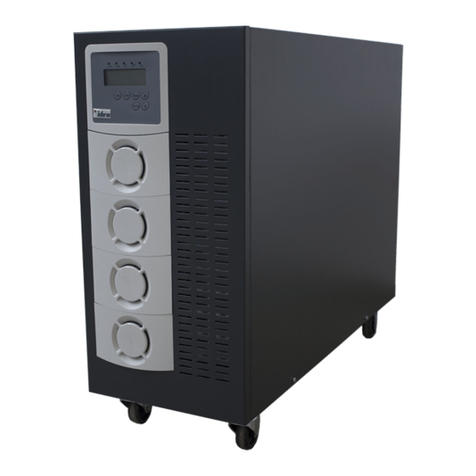
inform
inform DSP FLEXIPOWER SERIES User manual
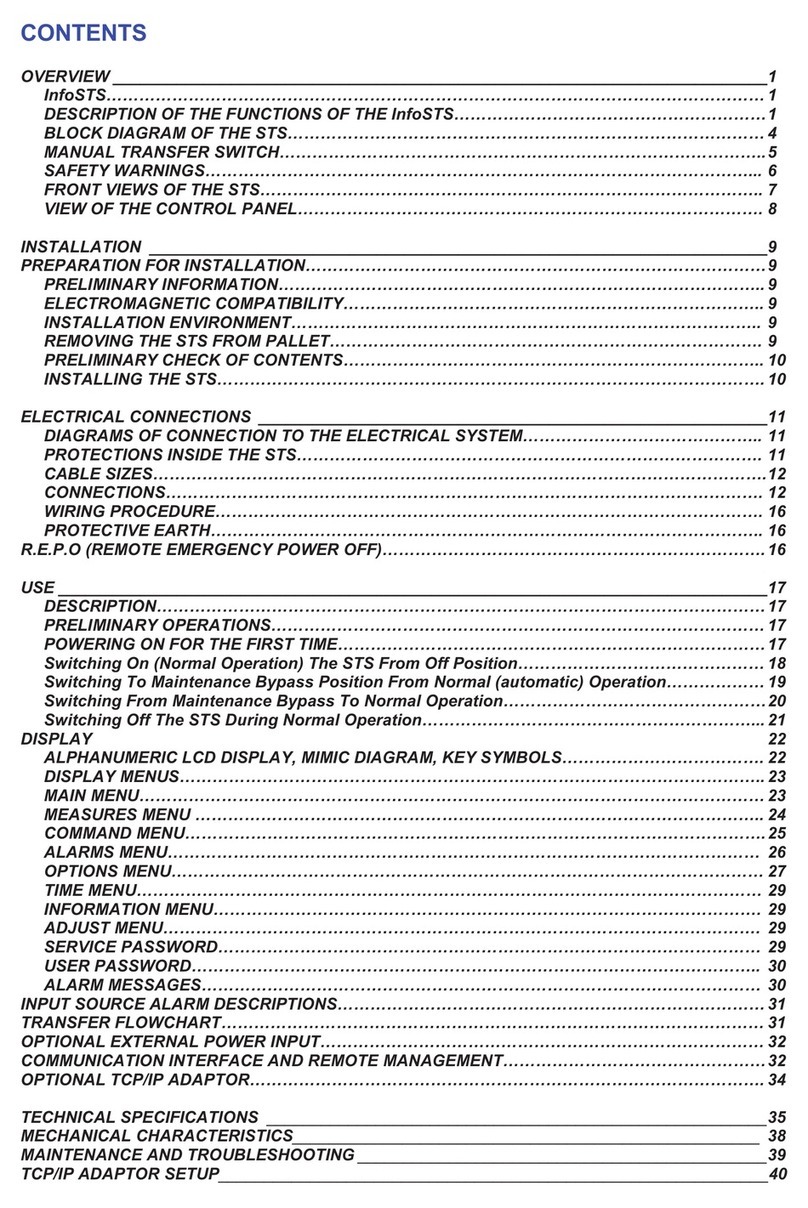
inform
inform InfoSTS User manual
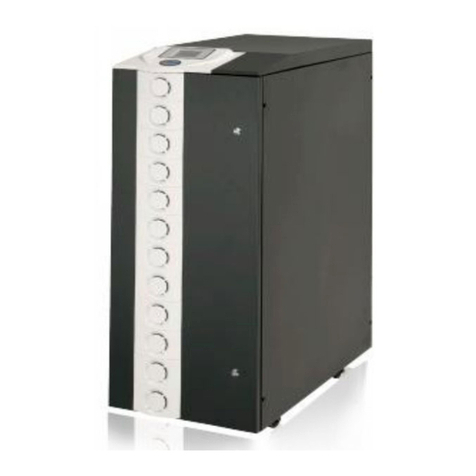
inform
inform PYRAMID DSP PREMIUM Series User manual
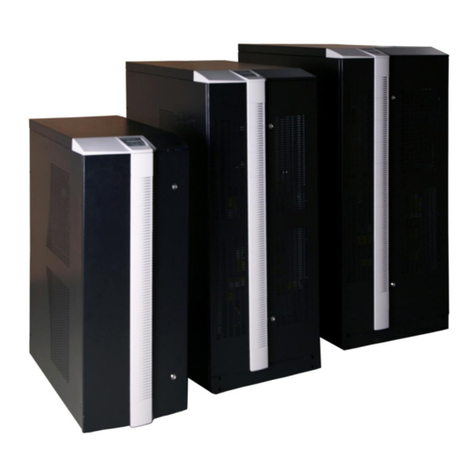
inform
inform PDSP31010 User manual
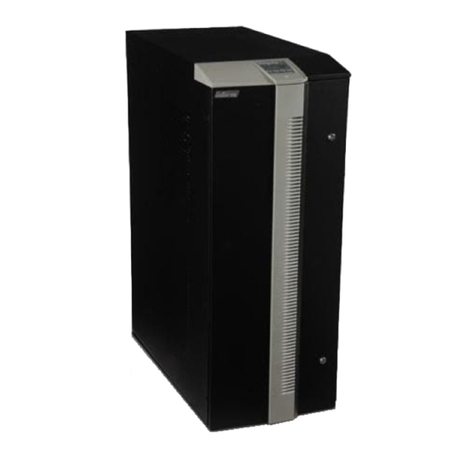
inform
inform DSP User manual
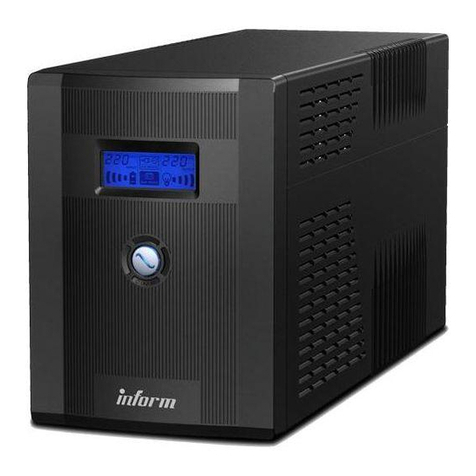
inform
inform GUARDIAN User manual
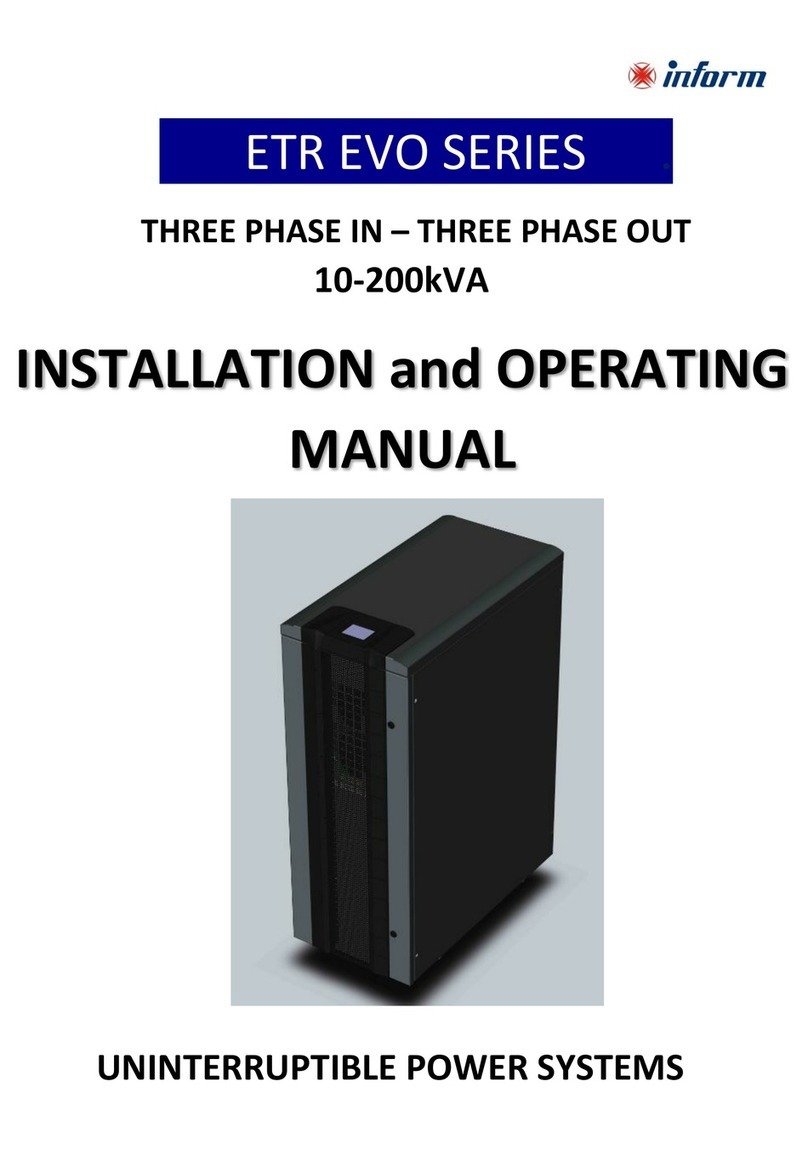
inform
inform ETR EVO Series User manual

inform
inform SAVER PLUS DSP SERIES User manual
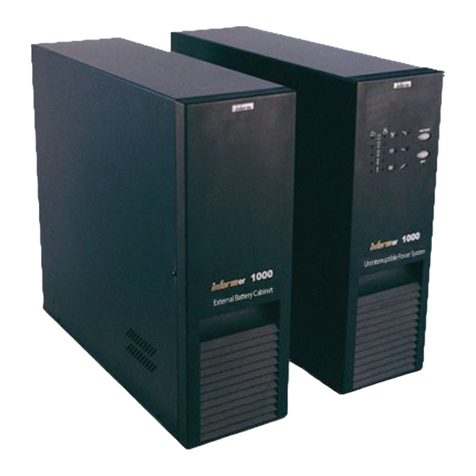
inform
inform Informer 1000VA User manual
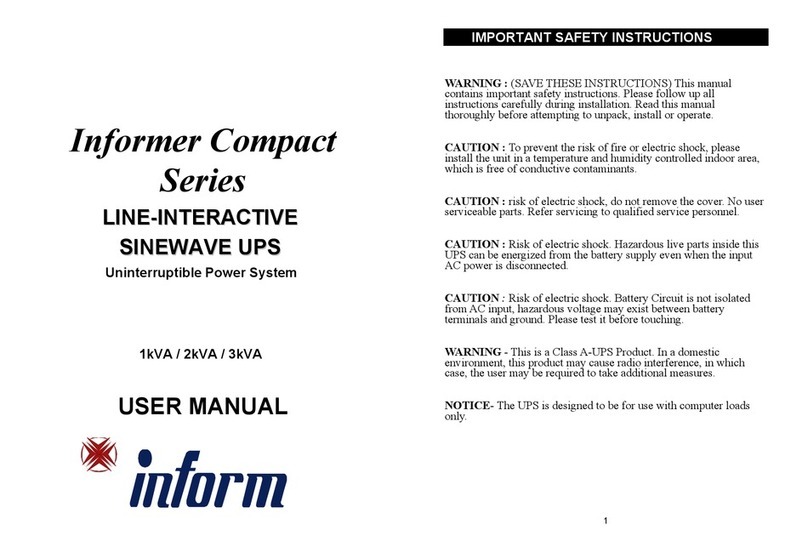
inform
inform Informer Compact Series User manual
